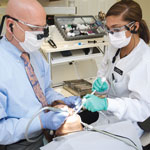
AND MY PRACTICE HAS BENEFITED EVER SINCE.
I was excited to read Dr. Bill Black’s article, “Making the Jump into Dental Implants” in the Spring 2014 issue of Aesthetic Dentistry. It felt like the general practitioner he was describing throughout the entire story was me! I personally made the jump into dental implants about eight years ago—only two years into my practice. Ever since that decision, my practice has reaped tremendous financial rewards.
Not On My Radar
When I first left dental school, dental implants were not on my radar. Yes, I learned about implants in school; however, they simply were not a subject that I had any interest in mastering at the time. The instructors didn’t seem too interested in having us master implants, either. Although the instructors didn’t say it outright, they indicated that this procedure would likely be something that we would refer out to specialists. So we focused on the basics and moved on. In our coursework, the only requirement was to take an impression of an implant abutment—just like a normal crown prep—and have a crown made. That was it!
The saying, “You don’t know what you don’t know,” definitely applied to my understanding of dental implants right out of dental school. At the time, I had no idea that this procedure could transform my practice from good to great. That misperception changed in 2004, when I met Dr. Dick Barnes while attending my first American Academy of Cosmetic Dentistry (AACD) conference in Nashville, Tennessee. I was so excited by the information in his lecture, that I had to meet him. After the presentation, I worked my way up to the front of the conference room and introduced myself. That day, Dr. Barnes challenged me to be more than just a normal, average dentist who only does fillings and crowns. “Do you want to be an extraordinary dentist?” Dr. Barnes asked.
Of course, I wanted to be an extraordinary dentist! I had never wanted to be average at anything, which is partly why I studied dentistry. I replied enthusiastically, “Just tell me what I need to do to get there, and I will get there!”
Dr. Barnes immediately invited me to attend the next month’s Arrowhead Dental Aesthetic Symposium. I accepted the invitation. There, I learned about the courses offered by the Dr. Dick Barnes Group, specifically the Implant EZ I and II courses. I eventually completed both of these courses and many of the others offered. The implant courses—surprisingly enough—became some of my favorites.
Implants Always ‘Win’
In the implant courses, Dr. John Julian was my mentor. Because of the critical implant truths that I learned from him, my mindset completely changed. First, Dr. Julian helped me understand how incredibly important implants are in comparison to fixed bridges and how they can far exceed the life expectancy and function of the latter. Dr. Julian explained that the reason is simple physics. A bridge requires two teeth to support the weight of three or more teeth, which is contrary to what teeth are designed to do. Teeth are structured to take on their own weight and are strategically placed in specific areas of the mouth, based on their shape and strength. They are not intended to take on the weight of the teeth around them. This design flaw in partials and bridges ultimately leads to failure.
Now, don’t get me wrong; some bridges (when seated properly) can last a very long time before the abutment teeth fail. My father is an amazing dentist and I have observed many of his bridges still functioning well after more than 30 years!
However, the problem with bridges is the bone loss that occurs because of the tooth loss. Without roots holding teeth to the bone, the bone begins to diminish, much like a paraplegic’s muscles atrophy due to disuse. When the jawbones do not get any stimulation, they eventually deteriorate and are lost. I’ve seen many examples of bridges ultimately failing and the loss of an already missing tooth, as well as one or both abutment teeth. This can always be attributed to bone deterioration and loss. If you have the option of maintaining the bone in a patient’s face, then as a dentist, you have an obligation to do so. Because of that, when it comes to the superiority of bridges or implants, implants always ‘win.’
After Dr. Julian explained this to me, my preference became clear; I wanted the very best for my patients and clearly the best was no longer with partials and bridges. The most innovative solution in dentistry (where tooth loss is concerned) is dental implants. I didn’t want to offer my patients anything less than the best.
In the courses, I was taught systematic methods for placing implants, and more importantly, how to be confident and comfortable when placing implants in tough situations. Dr. Julian’s explanations were so clear and so straightforward (accompanied by neatly organized, diagrammed procedural steps), a 10-year-old could have easily followed. Well, maybe not a 10-year-old, but you know what I mean. At that moment, my journey into dental implants really began. I had made a giant leap off the side of the pool and jumped into the deep end of implants with a perfect swan dive.
 When I completed my first implant case, I was (of course) a little nervous. Honestly, who wouldn’t be? I placed two implants on my first case and it was stressful. However, I’m proud to say that everything went smoothly and today, those implants are still performing and functioning as they should. Every implant case gets easier and my techniques increasingly improve, too. I can honestly say that the decision to do implants was one of the best decisions of my career thus far. I am often asked, “How have implants benefited my practice?” My answer is always one word, in all caps with two exclamation points at the end—TREMENDOUSLY!!
When I completed my first implant case, I was (of course) a little nervous. Honestly, who wouldn’t be? I placed two implants on my first case and it was stressful. However, I’m proud to say that everything went smoothly and today, those implants are still performing and functioning as they should. Every implant case gets easier and my techniques increasingly improve, too. I can honestly say that the decision to do implants was one of the best decisions of my career thus far. I am often asked, “How have implants benefited my practice?” My answer is always one word, in all caps with two exclamation points at the end—TREMENDOUSLY!!
Implants Transformed My Practice
When I first started doing implants, I set a simple goal: do at least one implant every month. Now, just eight years later, implants account for a quarter of my practice! Keep in mind, I don’t do every implant case that comes into my office. I agree with Dr. Black’s advice regarding case selection and I recommend the same advice to my fellow general practitioners. Only do the cases that are straightforward, “easy, breezy cases” and send the extremely challenging and time-consuming ones to specialists. Don’t worry that there won’t be enough work to do. I refer out a lot of cases, but remember, implants account for a quarter of my practice. There is enough work for everyone to ‘get a piece of the implant pie.’
Currently, out of all the general practitioners in my area, I am one of only a few who offers implants to patients. You might think that specialists would be annoyed that I am taking away their business. On the contrary! Several specialists have told me that I refer more implant cases to them than any other dentist in the area. How can that possibly be when I do so many myself?
The answer is a combination of education, perception, and action. If you are not educated about a procedure, you won’t even see the possibilities. With regards to implants, if you are not educated on the ease and placement of implants, then when you look at someone’s mouth, you will only see the need for partials and bridges. The idea of an implant for a patient will never cross your mind. If all you know are partials and bridges, then those are the only possibilities you will see.
So when I became trained on implants, I started seeing them as a possibility for my patients. I therefore started doing more and also started referring more implants to specialists. Instead of giving my patient a partial or a bridge (as I would have done before), I gave the patient a superior restoration option by offering an implant.
When I made the jump into dental implants, one of the biggest obstacles I had was patient education. After dental school, I went into business with my dad and inherited a patient population that was much older than me. I was a young dentist, right out of dental school, with revolutionary and radical ideas. I was the ‘Christopher Columbus’ of our dental practice, and it was difficult to get anyone to buy into my idea that there was a proverbial better route to the Indies than with the old-school partials and bridges that we had been using!
At first, many of the patients were uncomfortable with my pioneering ways. They wanted to just continue with the dentistry that they already knew and were comfortable with. And to be honest, so was my staff. Initially, they weren’t so sure if they wanted to jump into the implant pool with me, either. I had to convince all of them to jump on in—the water was just fine!
I did that by spending a great deal of effort on education. I worked on my presentation methods and eventually found a way to help both my patients and my staff understand the benefits of the implant procedure and feel comfortable with it as an option.
One method (which I still use) for patients who need dental implants is have a ‘show and tell’ demonstration with them. In the demonstration, I show what an implant looks like. I explain how it works. I show and explain how it is superior to the other available restoration options. By so doing, I raise the dental IQ of the patients and ultimately let them decide what is best for their situation.
With implants, the office must be particularly careful with its aseptic environment. This is of utmost importance for a surgical procedure like implants. To avoid possible contamination and cross-contamination of the environment and instruments, I assign specific responsibilities to specific individuals. For example, one assistant is dedicated to the chair-side work while another assistant’s job is to get X-rays, adjust the light, and remember not to touch any instruments in the procedure. By giving everyone very specific assignments, we mitigate the chance of contamination.
My team is fantastic and is willing to learn and adapt to new situations. They know that I’m a continuing education fanatic! My passion is teaching my staff and educating my patients. Therefore, my team is always on board for the updates and trainings that I provide regarding ways to improve our dental implant procedures.
Making the Jump
Because of my positive experiences, general practitioners should also consider jumping into this exciting field of dental implants. Remember what the famous astronaut Neil Armstrong said when he made his first revolutionary step onto the silvery surface of the moon more than 45 years ago on July 20, 1969: “That’s one small step for man, one giant leap for mankind.”
Adding dental implants to your practice may be a small step for you. But it will be a giant leap forward for your practice. It’ll transform your practice with a level of productivity that you never dreamed was possible. Your patients will also be transported to a world of better form and function because you offered them an innovative restoration procedure in your own office.
Now, I give you the same challenge that Dr. Barnes gave me at the lecture in Nashville years ago: “Do you want to become an extraordinary dentist?” I hope your answer is a resounding, “Yes!”
CLICK HERE to read oral surgeon Dr. Bill Black’s article “Making the Jump into Dental Implants” from our Spring 2014 Issue.









